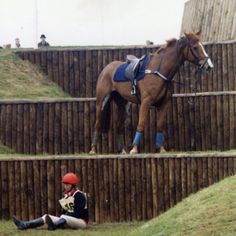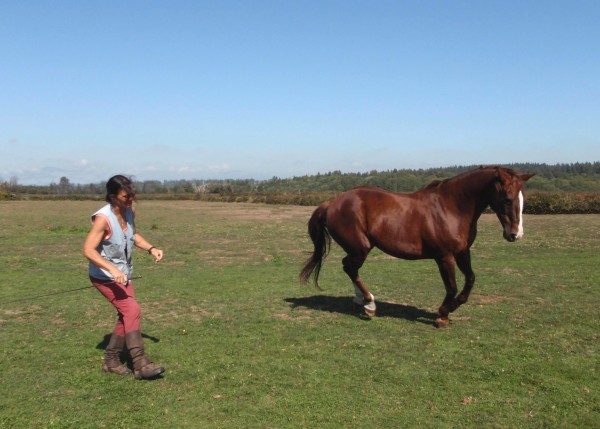- So what was it that the horse in the first picture of the last Blog says? The solution was in the series “Understanding your Horse” in Blog 08.
- Now, after having learned “The SECRET” and how the very best trainers in the world do it, we have to delve a bit deeper into the details. It is most important to understand the underlying structure of these learning experiences, because only thus is the experience learning units in such a way that they experience maximal sense of achievement. That triggers motivation, joy and therefore voluntary cooperation of the trainee.
Conditioning:
- Please jump back to the series about “The IQ of your horse” part 04. That is where we explained classical and operant conditioning. Classical conditioning is automatic learning (Pawlow). Only with operant conditioning we are dealing with voluntary learning of our horse – therefore only this is of interest to us!
No tricks!
- Many people understand the concept of “conditioning” as negative out of ignorance, they consider horses, which are trained with conditioning, as weak-willed animals, which have been manipulated into showing “tricks”. In reality the opposite is the case!
- Please also review once more part 06 in the same series, where we talk about the importance of reinforcement. With operant conditioning the horse learns to connect his own actions with their results (the consequence!) and to make his own decision following this experience as to which solution to choose! Of course this is motivating – while coercion never is.
- So we allow the pupil to look for solutions and try them out – but we help him to the right path by reinforcing any correct approach.
Trial and error should lead to “fitness improvement”:
- We know by now that animals learn mainly through experiences, by trying to solve tasks through trial and error. The horse (in our case) reacts to incentives (stimuli) from the outside – and if his reaction (i.e. his chosen behaviour) leads to success (to an amelioration of his condition, the “fitness improvement” in Eva Wiemers’ book) repeatedly, then his brain will make the connection between such a situation and his own action – BINGO! An association has happened – the horse is LEARNING. If such a linking is long-term, we speak of “conditioning”.
The ABC of Learning:
… follows the way in which such associations are formed in nature, which are then consolidated in the neural network and form “roads with a right-of-way” in the brain (E.W.) as they lead securely and quickly to success. |
|
- Was also sagte das Pferd im ersten Bild des letzten Blogs? Die Lösung war in der Serie „Understanding your Horse“ im Teil 08 zu finden.
- Nun, nachdem wir das „GEHEIMNIS“ erfahren haben und wissen, wie die weltbesten Trainer damit umgehen, müssen wir tiefer in die Details einsteigen. Es ist sehr wichtig, die zugrundeliegende Struktur dieser Lernerfahrungen zu verstehen, denn nur so kann der Erfolg garantiert werden. Das ABC läßt Tiere so ihre Lernerfahrungen machen, daß sie dabei maximale Erfolgserlebnisse haben. Das löst Motivation aus, Freude, und daher freiwillige Mitarbeit des Schülers.
Konditionierung:
- Bitte springen Sie noch einmal in die Serie „Der IQ Ihres Pferdes“, Teil 04. Hier werden klassische und operante Konditionierung erklärt. Klassische Konditionierung ist automatisches Lernen (Pawlow). Nur bei der operanten Konditionierung handelt es sich um freiwilliges Lernen des Pferdes – daher ist sie die für uns interessante!
Keine Tricks!
- Viele Menschen verstehen den Begriff „Konditionierung“ aus Unwissen negativ, sie halten mit Konditionierung trainierte Pferde für willenlos handelnde Lebewesen, die durch Manipulation dazu gebracht wurden, „Tricks“ zu zeigen. Tatsächlich ist das Gegenteil der Fall!
- Lesen Sie ebenfalls noch einmal in oben genannter Serie den Teil 06, wo die Bedeutung des Verstärkens definiert wird. Bei der operanten Konditionierung lernt das Pferd seine eigenen Aktionen mit deren Folgen (die Konsequenzen!) zu verknüpfen – und aus dieser Erfahrung heraus selbst zu entscheiden, welche Lösung es wählt! Das ist natürlich motivierend – Zwang ist das niemals.
- Wir erlauben dem Schüler also Lösungen selber zu suchen und auszuprobieren – aber wir helfen ihm auf den richtigen Weg, indem wir richtige Ansätze „bestärken“.
Empirisches Ausprobieren sollte zu „Fitnessverbesserung“ führen:
- Wir wissen ja nun, daß Tiere hauptsächlich durch Erfahrung lernen, indem sie Aufgaben mit der Probiermethode zu lösen versuchen. Das Pferd (in unserem Fall) reagiert dabei auf Anreize (Stimuli) von außen – und wenn seine Reaktion (sein Verhalten) wiederholt zu Erfolg führt (d.h. zu „Fitnessverbesserung“ wie Eva Wiemers das nennt), dann wird sein Gehirn eine Verbindung zwischen der Situation und seinem eigenen Verhalten herstellen – VOLLTREFFER! Es ist eine Assoziation entstanden – das Pferd hat GELERNT. Wenn daraus eine dauerhafte Verknüpfung entsteht, sprechen wir von „Konditionierung“.
Das ABC des Lernens:
… folgt der Art, wie solche Verknüpfungen in der Natur entstehen, die sich dann im neuralen Netzwerk festigen und sozusagen „Vorfahrsstraßen im Gehirn“ (E.W.) bilden, da sie zügig und sicher zum Erfolg führen. |
What is this ABC?
- The letters stand each one for one of the three constituents of the process of conditioning:
Antecedent – Behaviour – Consequence
- You can google Ted Turner’s ABC of Behavior Shaping. You will also find a Proactive Behavior Management Seminar 2 DVD set – but, in contrast to the fantastic book by Eva Wiemers (unfortunately only in German so far), his teachings do not give you specific hints about horses.
So I summarize the book by E.W.
The A, the Antecedent :
I quote E.W..:
„The antecedent includes all conditions, which either trigger a behaviour or make it possible, or make it probable, respectively”
- Store of incentives: the memories of earlier happenings in learning situations – only the good, joyful ones are useful for positive training!
- lead-up: everything in a given situation (including emotional as well as biological factors and the environment), which has to be arranged in such a way as to make it very probable that a success will be reached.
- the kick-off or starting whistle: which allows the horse to show the encouraged behaviour joyfully and by his own choice – leaving him the possibility to NOT perform!
|
|
Was ist dieses ABC?
- Die Buchstaben stehen für die drei Konstituenten des Konditionierungsvorgangs.
Ausgangslage – B=Verhalten – C=Konsequenz
- Das originale ABC stammt von Ted Turner, den Sie leicht googlen können. Im Gegensatz zu dem Buch s.u. beschäftigt sich sein Training aber nicht speziell mit Pferden!
- Die jetzt folgende Besprechung ist sehr gekürzt. Im Buch „Wer lernt mit uns?“ von Eva Wiemers wird das ABC in allen Einzelheiten besprochen, und ich kann wirklich nur empfehlen, es dort nachzulesen.
E.W. gibt auch immer wieder humoristische und sehr klare Beispiele, die ich sehr nützlich finde!
Das A, Die Ausgangslage
Ich zitiere E.W.:
„Die Ausgangslage erfasst alle Bedingungen, die das Verhalten entweder auslösen oder ermöglichen, bzw. wahrscheinlich machen“
- Anreizfundus: die Erinnerungen an frühere Erlebnisse aus Lernsituationen – nur die guten, freudigen Erinnerungen sind für ein positives Training nützlich!
- Auftakt: Das ganze Umfeld einer gegebenen Situation (inklusive psychische oder biologische Faktoren), welches so gestaltet werden muß, daß ein Erfolg mit großer Wahrscheinlichkeit eintritt.
- und Anpfiff (Startsignal): welches dem Tier erlaubt, von sich aus und freudig das „angepfiffene“ Verhalten zu zeigen – es könnte es aber auch nicht tun!
|
Promising what?
- I will omit here all examples of actions and consequences which might be „fitness-improving“ for the horse in natural situations – you can find your own. Here we want to concentrate on “training and learning” – so it always includes us.
I quote E.W.:
- “The sticking point of any training with voluntary cooperation of the trainee is the choice and use of the “consequence C”! Since you as the trainer must administer those effectively later, you have to clearly understand what falls into this category!”
- You might already know from earlier Blogs that we show the horse the correct path by “reinforcing” desirable reactions.
- In the next Blog we will further look at concepts such as punishment and reward – and this is, where Eva Wiemers offers us a new way to understand the train of our horses according to the laws of shaping!
Read on !!!
|
|
Was verspricht es sich?
- Ich werde hier alle Beispiele solchen Verhaltens und Folgen auslassen, die das Pferd in der Natur als „fitnessverbessernd“ empfinden kann – lesen Sie das Buch „Wer lernt mit uns?“ für jede Menge Beispiele. Hier konzentrieren wir uns auf „Training und Lernen“, so daß es immer uns mit einschließt.
Ich zitiere E.W.:
- „Knackpunkte des Trainings von freiwilligem Verhalten sind Auswahl und Anwendung der Konsequenzen C. Da Sie der Trainer sind, der diese später erfolgreich verwalten will, machen Sie sich als Nächstes klar, was alles darunter zu verstehen ist.“
- Aus früheren Blogs wissen Sie ja vielleicht schon, daß wir dem Pferd den korrekten Weg durch „Bestärkung“ erwünschten Verhaltens aufzeigen.
- Im nächsten Blog werden wir weiter solche Begriffe wie Strafe und Belohnung beleuchten – und hier bietet Eva Wiemers uns wirklich eine neue Weise das Training unserer Pferde nach den Gesetzen des Formens zu verstehen!
Lesen Sie weiter !!
|



